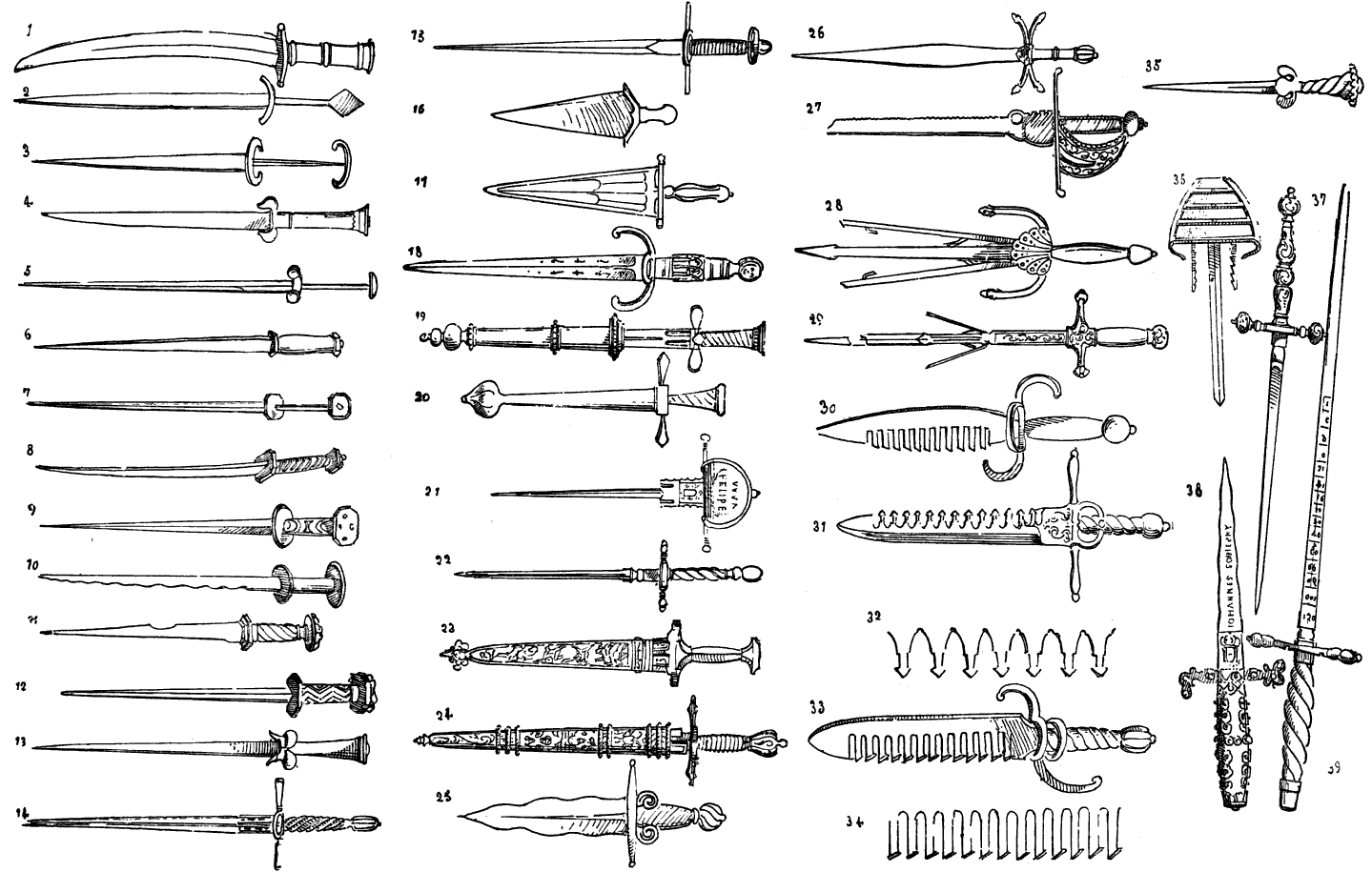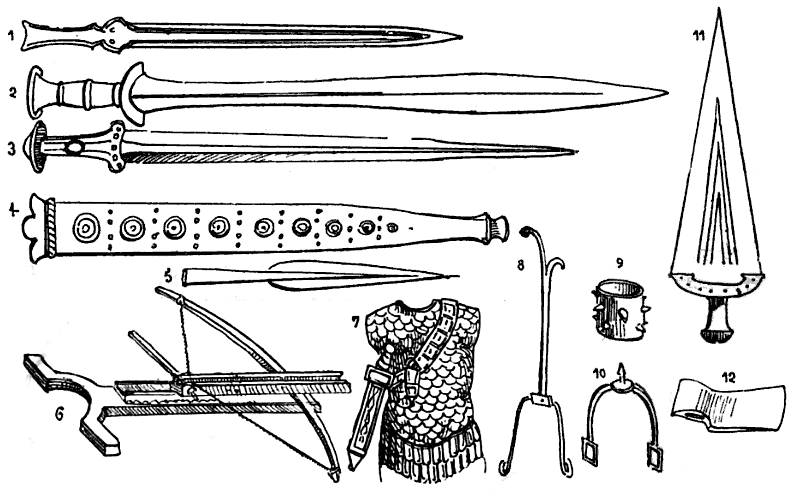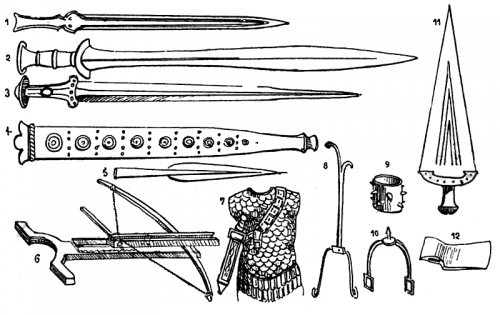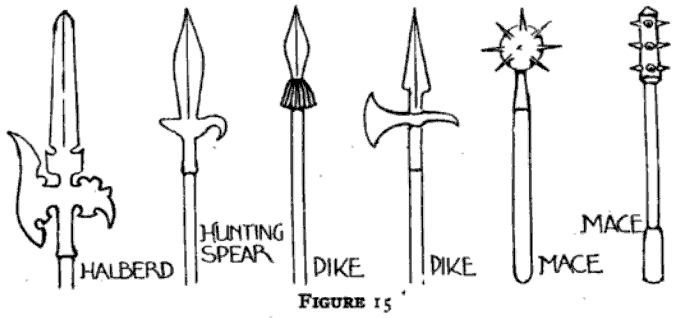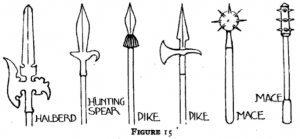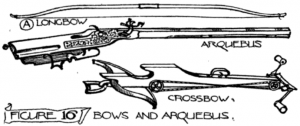I’ve previously shown illustrations and descriptions of Ancient Egyptian weapons,  Ancient Greek helmets and weapons, and Ancient Roman weapons. Here are some daggers and poniards from the Christian Middle Ages.
- British cutlass, tenth century. It bears on the blade the names “Edwardus,” and “prins agile.” It is attributed to Edward II.
- Iron dagger, about a foot long, thirteenth century.
- Iron dagger, thirteenth century. Blade measures about 12 inches, and the haft about 5 inches.
- Iron poniard, probably Scottish, fourteenth century.
- Same as above.
- Poniard, beginning of the fourteenth century.
- Iron dagger, about 14 inches long, beginning of the fourteenth century. The haft is very long.
- Iron dagger, about 19 1/2 inches long, end of the fourteenth century.
- Iron dagger, 14 1/2 inches long, end of the fourteenth century. The handle is of carved bone.
- Iron dagger, end of the fourteenth or beginning of the fifteenth century.
- Poniard, end of the fourteenth century.
- Dagger, fifteenth century.
- Scottish dagger, about 14 1/2 inches long, wooden handle, fifteenth century.
- Dagger with single thumb ring, about 16 inches long, fifteenth century.
- Dagger with double thumb ring, sixteenth century. The two rings were placed there to fix the dagger on a shaft, or at the end of a lance, to resist cavalry.
- Dagger, anelace, or Verona dagger, fifteenth century.
- Dagger, anelace, fifteenth century.
- Dagger, fifteenth century.
- Dagger of a German lansquenet, sixteenth century, about 14 inches long. Polished steel sheath.
- Dagger of German lansquenet, sixteenth century.
- Main gauche, Spanish, with the inscription “Viva Felipe V.,” which shows that this weapon was in use in the year 1701.
- Stiletto (Spitzdolch), about 12 inches long, end of the sixteenth century. In Germany these weapons were also called Panzerbrecher, or cuirass-breaker.
- Dagger, Swiss, sixteenth century. These daggers are often provided with small knives, which served to cut the thongs of the armour, to pierce holes, and for various purposes.
- Dagger, German, sixteenth century.
- Poniard, German, with wavy blade, very short and broad.
- Poniard, German, sixteenth century. The guard has four quillons.
- Main gauche, sixteenth century.
- Main gauche, German, sixteenth century.
- Main gauche, German, about 20 inches long, sixteenth century. Engraved handle.
- Main gauche, German, with indented blade for breaking the enemy’s sword; thumb ring, and quillons curved in inverse directions; sixteenth century.
- Main gauche, German, with indented blade for breaking swords, sixteenth century.
- Close-up of indented blade of previous dagger.
- Large German brise-épée, sixteenth century.
- Close-up of indented blade of previous dagger.
- Poniard, German, sixteenth century.
- Large main gauche, German, with indented quillons, and grated guard as sword-breaker, seventeenth century. It measures about 25 by 10 inches.
- Stiletto, German, called Panzerbrecher, or cuirass-breaker, about 12 inches long, sixteenth century.
- Poniard, about 10 inches long, richly studded with precious stones. This weapon belonged to Sobieski, King of Poland.
- Poniard, German, called Panzerbrecher. The numbers on the blade probably used for measuring the bore of cannons.
The illustrations and descriptions have been taken from An Illustrated History of Arms and Armour: From the Earliest Period to the Present Time, by Auguste Demmin, and translated by Charles Christopher Black. Published in 1894 by George Bell.

